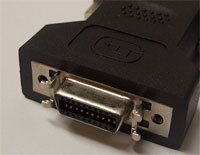Difference Between DVI and DVI-D
 DVI vs DVI-D
DVI vs DVI-D
The Digital Visual Interface or DVI is rapidly gaining popularity, especially with the rapid growth of digital displays like LCDs and LEDs. DVI is the definition of the whole interface but there are subcategories that define each aspect; one of these is DVI-D. The extra D in DVI-D stands for digital as it defines the digital components of the interface.
Although DVI was created to facilitate the digital transmission of video data, the need to retain backwards compatibility with older displays and video adapters that are not capable of processing digital signals was very great. DVI includes provisions for the transmission of analog signals so that with the use of adapters, you can connect a VGA display to a VGA port or vice versa. DVI-D omits this capability making it incompatible with non digital devices, regardless of whether they have DVI ports or not. This was achieved by simply removing the pins and wiring that was supposed to carry the analog signals. These are the four pins that surround the long flat pin on one end of the connector
To make it easier for people to realize that they are using an incompatible connector and not keep on wondering why their computer is not functioning, the designers of DVI modified the connectors and the ports. Since DVI-D ports lack the slots for the four analog pins, you should not be able to connect any other DVI connector to a DVI-D port. But even if you remove the four analog pins on the connector, you would still be unable to fit it in as the long flat pin of DVI-D is narrower; meaning that the slot on the corresponding DVI-D port is also narrower and cannot take other connectors.
It is possible though to connect a DVI-D connector into a DVI-I slot or the universal slot that accepts all types of cables. This allows digital only LCD displays to connect to the universal port on the computer.
Summary:
1. DVI is the general standard for the interface while DVI-D defines the digital components of the interface
2. DVI connectors are capable of transmitting both analog and digital signals while DVI-D connectors are only capable of transmitting digital signals and not analog
3. DVI-D connectors lack the wiring for analog signals that is found on other DVI connectors
4. DVI-D ports are not able to take other types of DVI connectors
5. DVI-D connectors can be slotted into DVI-I ports
- Difference Between Fish and Reptiles - August 10, 2011
- Difference Between Xeon and i7 - January 7, 2010
- Difference Between GPS and AGPS - December 20, 2009

Image, as i know, represent analog VGA, but not DVI interface.